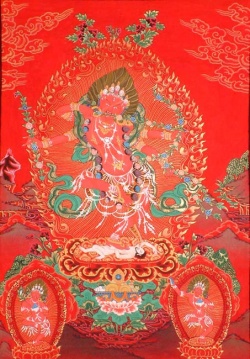Profound Inner Meaning
Profound Inner Meaning or 'Zabmo Nangdon' (Tibetan: ཟབ་མོ་ནང་དོན, Wylie: zab mo nang don) is a major work of 'Rangjung Dorje' (Tibetan: རང་འབྱུང་རྡོ་རྗེ, Wylie: rang 'byung rdo rje) (1284–1339), the third Karmapa, born to a Nyingma family he received the full transmission of the Nyingma tradition, in addition to the Karma Kagyu.
Nomenclature, orthography and etymology
'Rangjung Dorje' (Tibetan: རང་འབྱུང་རྡོ་རྗེ, Wylie: rang 'byung rdo rje)
Exegesis
Rangjung Dorje was a noted scholar who composed many significant texts, the most famous of which is the Profound Inner Meaning (Wylie: zab mo nang don), which concern the Vajrayana inner yoga practices.
Schaeffer (1995: p. 16) advises that the text is 'verse' (Sanskrit: karika) in eleven chapters regarding the Anuttarayogatantras:
- "Rang byung's most famous, and perhaps most difficult work is yet another verse text, his Zab mo nang don, on the Anuttarayogatantras.
This eleven-chapter work is thirty-two folios in length.
According to a colophon provided by Kong sprul, it was written in the Water Male Dog year, 1322, at Bde chen steng.
The colophons to the present redactions say only that it was written in the Dog Year."
Structure
Summary
The first chapter covers the 'causes' (Sanskrit: hetu) and 'conditions' (Sanskrit: pratyaya) for Samsara and Nirvana.
The second chapter discusses the esoteric understanding of the development of the body in the womb which has direct relevance to the Generation stage.
The text then discusses Nadis, the five 'winds' Prana/Vayu (Sanskrit) and 'breathwork' (Sanskrit: pranayama) and the 'Four States' which are stages of the Generation Phase.
Correspondence between 'inner' and 'outer' which broaches nonduality and the Two truths.
'Imputed deities' which discusses the yoga of the 'illusory body', yidam and tulpa.
'Bases' discusses the Eighteen Dhatu and Upaya.
Ten, discusses Bhumi and Lamrim.
Chapter eleven closes with Completion stage.
Chapters
The Tsadra Foundation (2008) lists the following chapters in the Profound Inner Meaning, also rendered into English:
{{Nolinking|* Introduction
- One: The Causes and Conditions for Saṃsāra and Nirvāṇa
- Two: Development of Body in Womb
- Three: Nāḍīs
- Four: Prāṇas
- Five: Bindus
- Six: The Four States
- Seven: Correspondence between Inner and Outer
- Eight: Imputed Deities
- Nine: Bases and Means of Purification
- Ten: Stages of the Path
- Eleven: Dissolution
- Conclusion: Vidyādhara piṭaka
Commentary
Jamgon Kongtrul did a commentary on the text which has been given the English gloss 'Illuminating the Profound Meaning: a Commentary to The Profound Inner Meaning (Zabdon Nangjey)'.
Editions
- Karamapa III, Rangjung Dorje. zab mo nang gi don zhes bya ba'i gzhung and rnal 'byor bla med pa'i rgyud sde rgya mtsho'i snying po bsdus pa zab mo nang gi don nyung ngu'i tshig gis rnam par 'grol ba zab don snang byed. (The Profound Inner Meaning.) Rumtek, Sikkim: Karmapa'i chos sgar, n.d.


